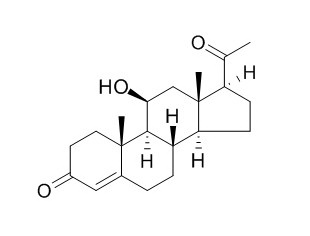11Beta-hydroxyprogesterone
The progesterone derivatives 11 alpha- and 11 beta-hydroxyprogesterone are potent inhibitors of 11 beta-hydroxysteroid dehydrogenase (isoforms 1 and 2) in vitro and can confer mineralocorticoid activity on corticosterone in the rat in vivo. 11beta-Hydroxyprogesterone acts as a mineralocorticoid agonist in stimulating Na+ absorption in mammalian principal cortical collecting duct cells.
Inquire / Order:
manager@chemfaces.com
Technical Inquiries:
service@chemfaces.com
Tel:
+86-27-84237783
Fax:
+86-27-84254680
Address:
1 Building, No. 83, CheCheng Rd., Wuhan Economic and Technological Development Zone, Wuhan, Hubei 430056, PRC
Providing storage is as stated on the product vial and the vial is kept tightly sealed, the product can be stored for up to
24 months(2-8C).
Wherever possible, you should prepare and use solutions on the same day. However, if you need to make up stock solutions in advance, we recommend that you store the solution as aliquots in tightly sealed vials at -20C. Generally, these will be useable for up to two weeks. Before use, and prior to opening the vial we recommend that you allow your product to equilibrate to room temperature for at least 1 hour.
Need more advice on solubility, usage and handling? Please email to: service@chemfaces.com
The packaging of the product may have turned upside down during transportation, resulting in the natural compounds adhering to the neck or cap of the vial. take the vial out of its packaging and gently shake to let the compounds fall to the bottom of the vial. for liquid products, centrifuge at 200-500 RPM to gather the liquid at the bottom of the vial. try to avoid loss or contamination during handling.
Food Chem.2023, 424:136383.
Evid Based Complement Alternat Med.2020, 2020:1970349.
Applied Biological Chemistry2022, 65(12)
J Korean Society of Food Science & Nutrition2021, 50(9): 962-970
Appl Biochem Biotechnol.2020, 190(2):732-744
J Nat Prod.2022, doi: 10.1021
Forensic Sci Int.2022, 341:111475.
Redox Rep.2024, 29(1):2392329.
J Food Sci Technol.2019, 56(5):2712-2720
Chinese Medicine2019, 14(1)
Related and Featured Products
Hypertension. 1996 Mar;27(3 Pt 1):421-5.
11alpha- and 11beta-hydroxyprogesterone, potent inhibitors of 11 beta-hydroxysteroid dehydrogenase, possess hypertensinogenic activity in the rat.[Pubmed:
8698448]
The progesterone derivatives 11alpha-hydroxyprogesterone and 11Beta-hydroxyprogesterone are potent inhibitors of 11 beta-hydroxysteroid dehydrogenase (isoforms 1 and 2) in vitro and can confer mineralocorticoid activity on corticosterone in the rat in vivo. 11beta-Hydroxysteroid dehydrogenase metabolizes active glucocorticoids to their inactive 11-dehydro products and protects renal mineralocorticoid receptors from the high circulating levels of endogenous glucocorticoids. 11 beta-Hydroxysteroid dehydrogenase has been suggested to be important not only in the control of renal sodium retention but also of blood pressure.
METHODS AND RESULTS:
To assess the possible blood pressure-modulating effects of 11alpha- and 11Beta-hydroxyprogesterone , we infused these substances into both intact and adrenalectomized Sprague-Dawley rats continuously for 14 days. Both 11alpha- and 11Beta-hydroxyprogesterone caused a significant elevation in blood pressure within 3 days, an effect that persisted throughout the 14-day infusion. The hypertensive effects of 11alpha-hydroxyprogesterone were abolished by adrenalectomy and significantly attenuated when 11alpha-hydroxyprogesterone was infused together with the specific mineralocorticoid receptor antagonist RU28318. In an additional series of experiments, 11alpha-hydroxyprogesterone significantly amplified the hypertensive effects of corticosterone in adrenalectomized spontaneously hypertensive rats but had no effects by itself in this experimental animal.
CONCLUSIONS:
These results demonstrate that both 11alpha-hydroxyprogesterone and 11Beta-hydroxyprogesterone are potently hypertensinogenic in the rat and that this activity depends on an intact adrenal and at least in part on the activation of mineralocorticoid receptors. 11Beta-hydroxyprogesterone , and similar endogenous progesterone metabolites that inhibit 11 beta-hydroxysteroid dehydrogenase, may be involved in the pathology of certain hypertensive states.
Mol Pharmacol. 2002 Dec;62(6):1306-13.
11Beta-hydroxyprogesterone acts as a mineralocorticoid agonist in stimulating Na+ absorption in mammalian principal cortical collecting duct cells.[Pubmed:
12435797]
The binding of mineralocorticoid hormones to the mineralocorticoid receptor is the first step in a cascade of events leading to the stimulation of Na(+) reabsorption by renal cortical collecting duct (CCD) principal cells. The agonist properties of mineralocorticoid hormones are linked to contacts between their 21-hydroxyl group and Asn770, a residue of the ligand-binding domain of the human mineralocorticoid receptor (hMR).
METHODS AND RESULTS:
Here, we investigate whether the presence of a hydroxyl group at position 11, 17, or 20 could also alter the activity of progesterone (P), a mineralocorticoid antagonist without the 21-hydroxyl group. Both 17 alpha-hydroxyprogesterone (17OHP) and 20 alpha-hydroxyprogesterone (20OHP) antagonized the aldosterone-induced trans-activation activity (IC(50): 17OHP, 10(-7) M; 20OHP, 10(-8) M) of the hMR transiently expressed in COS-7 cells lacking steroid receptors. In cultured mouse mpkCCD(cl4) principal cells, 17OHP and 20OHP also prevented the aldosterone-stimulated amiloride-sensitive component of the short-circuit current (Ams I(sc)), reflecting Na(+) absorption mediated by the epithelial Na(+) channel (ENaC). In contrast, 11 beta-hydroxyprogesterone (11OHP) activated the transiently expressed hMR in COS-7 cells in a dose-dependent manner (ED(50): 10(-8) M) and, like aldosterone, stimulated Ams I(sc) in mpkCCD(cl4) cells. Docking 11OHP within the hMR-ligand-binding domain homology model revealed that the agonist activity of 11OHP is caused by contacts between its 11 beta-hydroxyl group and Asn770. Furthermore, 11OHP was unable to activate the mutant hMR/N770A, in which Ala is substituted for Asn at position 770.
CONCLUSIONS:
These findings demonstrate that in the absence of the 21-hydroxyl group, the 11 beta-hydroxyl group can produce the contact with the hMR-Asn770 required for the hMR activation leading to stimulated Na(+) absorption.



